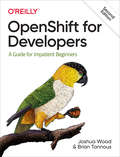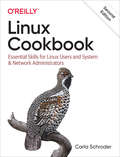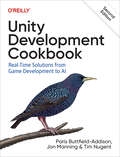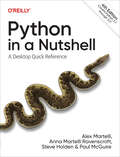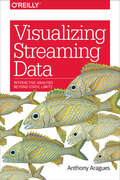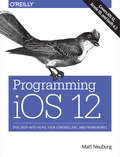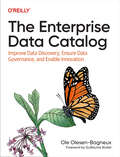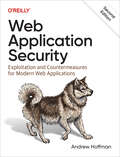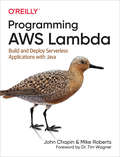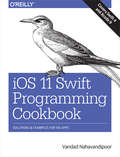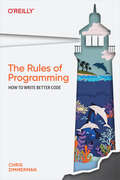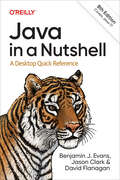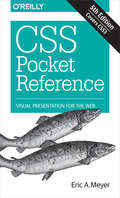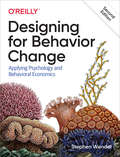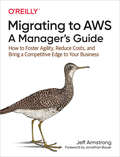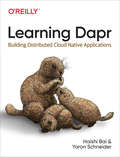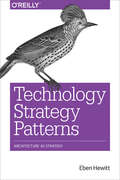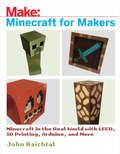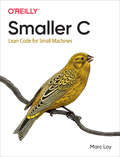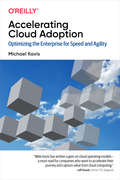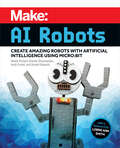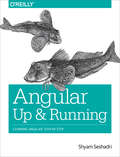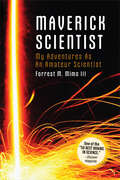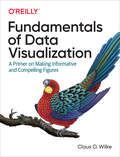- Table View
- List View
OpenShift for Developers: A Guide for Impatient Beginners
by Joshua Wood Brian TannousReady to build cloud native applications? Get a hands-on introduction to daily life as a developer crafting code on OpenShift, the open source container application platform from Red Hat. Creating and packaging your apps for deployment on modern distributed systems can be daunting. Too often, adding infrastructure value can complicate development. With this practical guide, you'll learn how to build, deploy, and manage a multitiered application on OpenShift.Authors Joshua Wood and Brian Tannous demonstrate how OpenShift speeds application development. With the Kubernetes container orchestrator at its core, OpenShift simplifies and automates the way you build, ship, and run code. You'll learn how to use OpenShift and the Quarkus Java framework to develop and deploy apps using proven enterprise technologies and practices that you can apply to code in any language.Learn the development cycles for building and deploying on OpenShift, and the tools that drive themUse OpenShift to build, deploy, and manage the ongoing lifecycle of an n-tier applicationCreate a continuous integration and deployment pipeline to turn your source code changes into production rolloutsAutomate scaling decisions with metrics and trigger lifecycle events with webhooks
Linux Cookbook: Essential Skills for Linux Users and System & Network Administrators (Linux Ser.)
by Carla SchroderThis handy cookbook teaches new-to-intermediate Linux users the essential skills necessary to manage a Linux system, using both graphical and command-line tools. Whether you run Linux in embedded, desktop, server, or cloud or virtual environments, the fundamental skills are the same. This book aims to get you up and running quickly, with copy-paste examples.Carla Schroder provides recipes that cover specific problems, with discussions that explain how each recipe works, as well as references for additional study.You'll learn how to:Use systemd, the new comprehensive service managerBuild simple or complex firewalls with firewalldSet up secure network connections for Linux systems and mobile devicesRescue nonbooting systemsReset lost passwords on Linux and WindowsUse dnsmasq to simplify managing your LAN name servicesManage users and groups and control access to filesProbe your computer hardware and monitor hardware healthManage the GRUB bootloader and multiboot Linux and WindowsKeep accurate time across your network with the newest toolsBuild an internet router/firewall on Raspberry PiManage filesystems and partitioning
Unity Development Cookbook: Real-Time Solutions from Game Development to AI
by Paris Buttfield-Addison Tim Nugent Jon ManningLearn everything you need to know to use the powerful Unity engine to its full potential for 3D and 2D game development, simulation, artificial intelligence, and beyond. From the basics of scripting to techniques for interactivity, AI and behavior, animation, narrative, and networking, this flexible, mind-bogglingly popular engine is useful for anything that needs visuals and real-time simulation.With this thoroughly updated problem-solving cookbook, beginner and intermediate Unity developers will learn about the Unity engine through brief recipes that teach specific features of the software and scripting systems. You'll apply a collection of snippets of code to address common scenarios such as properly keeping score, accepting input, and sharing state over the network.This cookbook pinpoints the problem, sets out the solution, and discusses how to solve your problem in the best and most straightforward way possible. You'll find solutions for:2D and 3D graphicsMath, physics, and character controlAnimation and movementBehavior and AISound and musicNarrative and dialogueInput and gameplayScripting and user interfaceSimulation and synthetic data creationNetworking and accessing web contentAnalytics and telemetry
Python in a Nutshell: A Desktop Quick Reference
by Alex Martelli Steve Holden Paul McGuire Anna Martelli RavenscroftPython was recently ranked as today's most popular programming language on the TIOBE index, thanks to its broad applicability to design and prototyping to testing, deployment, and maintenance. With this updated fourth edition, you'll learn how to get the most out of Python, whether you're a professional programmer or someone who needs this language to solve problems in a particular field.Carefully curated by recognized experts in Python, this new edition focuses on version 3.10, bringing this seminal work on the Python language fully up to date on five version releases, including preview coverage of upcoming 3.11 features.This handy guide will help you:Learn how Python represents data and program as objectsUnderstand the value and uses of type annotationsExamine which language features appeared in which recent versionsDiscover how to use modern Python idiomaticallyLearn ways to structure Python projects appropriatelyUnderstand how to debug Python code
Visualizing Streaming Data: Interactive Analysis Beyond Static Limits
by Anthony AraguesWhile tools for analyzing streaming and real-time data are gaining adoption, the ability to visualize these data types has yet to catch up. Dashboards are good at conveying daily or weekly data trends at a glance, though capturing snapshots when data is transforming from moment to moment is more difficult—but not impossible.With this practical guide, application designers, data scientists, and system administrators will explore ways to create visualizations that bring context and a sense of time to streaming text data. Author Anthony Aragues guides you through the concepts and tools you need to build visualizations for analyzing data as it arrives.Determine your company’s goals for visualizing streaming dataIdentify key data sources and learn how to stream themLearn practical methods for processing streaming dataBuild a client application for interacting with events, logs, and recordsExplore common components for visualizing streaming dataConsider analysis concepts for developing your visualizationDefine the dashboard’s layout, flow direction, and component movementImprove visualization quality and productivity through collaborationExplore use cases including security, IoT devices, and application data
Programming iOS 12: Dive Deep into Views, View Controllers, and Frameworks
by Matt NeuburgIf you’re grounded in the basics of Swift, Xcode, and the Cocoa framework, this book provides a structured explanation of all essential real-world iOS app components. Through deep exploration and copious code examples, you’ll learn how to create views, manipulate view controllers, and add features from iOS frameworks.Create, arrange, draw, layer, and animate views that respond to touchUse view controllers to manage multiple screens of interfaceMaster interface classes for scroll views, table views, text, popovers, split views, web views, and controlsDive into frameworks for sound, video, maps, and sensorsAccess user libraries: music, photos, contacts, and calendarExplore additional topics, including files, networking, and threadsStay up-to-date on iOS 12 innovations, such as User Notification framework improvements, as well as changes in Xcode 10 and Swift 4.2. All example code is available on GitHub for you to download, study, and run.Want to brush up on the basics? Pick up iOS 12 Programming Fundamentals with Swift to learn about Swift, Xcode, and Cocoa. Together with Programming iOS 12, you’ll gain a solid, rigorous, and practical understanding of iOS 12 development.
The Enterprise Data Catalog: Improve Data Discovery, Ensure Data Governance, and Enable Innovation
by Ole Olesen-BagneuxCombing the web is simple, but how do you search for data at work? It's difficult and time-consuming, and can sometimes seem impossible. This book introduces a practical solution: the data catalog. Data analysts, data scientists, and data engineers will learn how to create true data discovery in their organizations, making the catalog a key enabler for data-driven innovation and data governance. Author Ole Olesen-Bagneux explains the benefits of implementing a data catalog. You'll learn how to organize data for your catalog, search for what you need, and manage data within the catalog. Written from a data management perspective and from a library and information science perspective, this book helps you: Learn what a data catalog is and how it can help your organization Organize data and its sources into domains and describe them with metadataSearch data using very simple-to-complex search techniques and learn to browse in domains, data lineage, and graphsManage the data in your company via a data catalogImplement a data catalog in a way that exactly matches the strategic priorities of your organizationUnderstand what the future has in store for data catalogs
Web Application Security: Exploitation and Countermeasures for Modern Web Applications
by Andrew HoffmanIn the first edition of this critically acclaimed book, Andrew Hoffman defined the three pillars of application security: reconnaissance, offense, and defense. In this revised and updated second edition, he examines dozens of related topics, from the latest types of attacks and mitigations to threat modeling, the secure software development lifecycle (SSDL/SDLC), and more.Hoffman, senior staff security engineer at Ripple, also provides information regarding exploits and mitigations for several additional web application technologies such as GraphQL, cloud-based deployments, content delivery networks (CDN) and server-side rendering (SSR). Following the curriculum from the first book, this second edition is split into three distinct pillars comprising three separate skill sets:Pillar 1: Recon—Learn techniques for mapping and documenting web applications remotely, including procedures for working with web applicationsPillar 2: Offense—Explore methods for attacking web applications using a number of highly effective exploits that have been proven by the best hackers in the world. These skills are valuable when used alongside the skills from Pillar 3.Pillar 3: Defense—Build on skills acquired in the first two parts to construct effective and long-lived mitigations for each of the attacks described in Pillar 2.
Programming AWS Lambda: Build and Deploy Serverless Applications with Java
by Mike Roberts John ChapinServerless revolutionizes the way organizations build and deploy software. With this hands-on guide, Java engineers will learn how to use their experience in the new world of serverless computing. You’ll discover how this cloud computing execution model can drastically decrease the complexity in developing and operating applications while reducing costs and time to market.Engineering leaders John Chapin and Mike Roberts guide you through the process of developing these applications using AWS Lambda, Amazon’s event-driven, serverless computing platform. You’ll learn how to prepare the development environment, program Lambda functions, and deploy and operate your serverless software. The chapters include exercises to help you through each aspect of the process.Get an introduction to serverless, functions as a service, and AWS LambdaLearn how to deploy working Lambda functions to the cloudProgram Lambda functions and learn how the Lambda platform integrates with other AWS servicesBuild and package Java-based Lambda code and dependenciesCreate serverless applications by building a serverless API and data pipelineTest your serverless applications using automated techniquesApply advanced techniques to build production-ready applicationsUnderstand both the gotchas and new opportunities of serverless architecture
iOS 11 Swift Programming Cookbook: Solutions and Examples for iOS Apps
by Vandad NahavandipooriOS 11, Swift 4, and Xcode 9 provide many new APIs for iOS developers. With this cookbook, you’ll learn more than 170 proven solutions for tackling the latest features in iOS 11 and watchOS 4, including new ways to use Swift and Xcode to make your day-to-day app development life easier. This collection of code-rich recipes also gets you up to speed on continuous delivery and continuous integration systems.Ideal for intermediate and advanced iOS developers looking to work with the newest version of iOS, these recipes include reusable code on GitHub, so you can put them to work in your project right away.Among the topics covered in this book:New features in Swift 4 and Xcode 9Tools for continuous delivery and continuous integrationSnapshot testing and test automationCreating document-based applicationsUpdated Map view and Core Location featuresiOS 11’s Security and Password AutofillData storage with Apple’s Core DataCreating lively user interfaces with UI DynamicsBuilding iMessage applications and sticker packagesIntegrating Siri into your apps with Siri KitCreating fascinating apps for Apple Watch
The Rules of Programming: How to Write Better Code
by Chris ZimmermanThis philosophy-of-programming guide presents a unique and entertaining take on how to think about programming. A collection of 21 pragmatic rules, each presented in a standalone chapter, captures the essential wisdom that every freshly minted programmer needs to know and provides thought-provoking insights for more seasoned programmers. Author Chris Zimmerman, cofounder of the video game studio Sucker Punch Productions, teaches basic truths of programming by wrapping them in memorable aphorisms and driving them home with examples drawn from real code. This practical guide also helps managers looking for ways to train new team members. The rules in this book include: As simple as possible, but no simplerLet your code tell its own storyLocalize complexityGeneralization takes three examplesWork backward from your result, not forward from your codeThe first lesson of optimization is don't optimizeA good name is the best documentationBugs are contagiousEliminate failure casesCode that isn't running doesn't workSometimes you just need to hammer the nails
Java in a Nutshell: A Desktop Quick Reference
by David Flanagan Benjamin J Evans Jason ClarkThis updated edition of the Nutshell guide not only helps experienced Java programmers get the most out of versions through Java 17, it also serves as a learning path for new developers. Chock-full of examples that demonstrate how to take complete advantage of modern Java APIs and development best practices, this thoroughly revised book includes new material on recent enhancements to the Java object model that every developer should know about.The first section provides a fast-paced, no-fluff introduction to the Java programming language and the core runtime aspects of the Java platform. The second section is a reference to core concepts and APIs that explains how to perform real programming work in the Java environment.Get up to speed on language details through Java 17Learn object-oriented programming using basic Java syntaxExplore generics, enumerations, annotations, and lambda expressionsUnderstand techniques used in object-oriented designExamine how concurrency and memory are intertwinedWork with Java collections and handle common data formatsDelve into Java's latest I/O APIs including asynchronous channelsBecome familiar with development tools in OpenJDK
CSS Pocket Reference: Visual Presentation for the Web (Pocket Reference (o'reilly) Ser.)
by Eric MeyerWhen youâ??re working with CSS and need an answer now, this concise yet comprehensive quick reference provides the essential information you need. Revised and updated for CSS3, this fifth edition is ideal for intermediate to advanced web designers and developers.Youâ??ll find a short introduction to the key concepts of CSS and alphabetical summaries of CSS selectors and properties. Youâ??ll also discover information on new properties, including grid, flexbox, clipping, masking, and compositing.Quickly find the information you needExplore CSS concepts, values, selectors and queries, and propertiesLearn how new features complement and extend your CSS practicesDiscover new properties including animations, grid, flexbox, masking, filtering, and compositing in this new edition
Designing for Behavior Change: Applying Psychology and Behavioral Economics
by Stephen WendelDesigners and managers hope their products become essential for users—integrated into their lives like Instagram, Lyft, and others have become. Such deep integration isn’t accidental: it’s a process of careful design and iterative learning, especially for technology companies. This guide shows you how to apply behavioral science—research that supports many products—to help your users achieve their goals using your product.In this updated edition, Stephen Wendel, head of behavioral science at Morningstar, takes you step-by-step through the process of incorporating behavioral science into product design and development. Product managers, UX and interaction designers, and data analysts will learn a simple and effective approach for identifying target users and behaviors, building the product, and gauging its effectiveness.Learn the three main strategies to help people change behaviorIdentify behaviors your target audience seeks to change—and obstacles that stand in their wayDevelop effective designs that are enjoyable to useMeasure your product’s impact and learn ways to improve itCombine behavioral science with data science to pinpoint problems and test potential solutions
Migrating to AWS: How to Foster Agility, Reduce Costs, and Bring a Competitive Edge to Your Business
by Jeff ArmstrongBring agility, cost savings, and a competitive edge to your business by migrating your IT infrastructure to AWS. With this practical book, executive and senior leadership and engineering and IT managers will examine the advantages, disadvantages, and common pitfalls when moving your company’s operations to the cloud.Author Jeff Armstrong brings years of practical hands-on experience helping dozens of enterprises make this corporate change. You’ll explore real-world examples from many organizations that have made—or attempted to make—this wide-ranging transition. Once you read this guide, you’ll be better prepared to evaluate your migration objectively before, during, and after the process in order to ensure success.Learn the benefits and drawbacks of migrating to AWS, including the risks to your business and technologyBegin the process by discovering the applications and servers in your environmentExamine the value of AWS migration when building your business caseAddress your operational readiness before you migrateDefine your AWS account structure and cloud governance controlsCreate your migration plan in waves of servers and applicationsRefactor applications that will benefit from using more cloud native resources
Learning Dapr
by Haishi Bai Yaron SchneiderGet the authoritative guide to Dapr, the distributed application runtime that works with new and existing programming languages alike. Written by the model’s creators, this introduction shows you how Dapr not only unifies stateless, stateful, and actor programming models but also runs everywhere—in the cloud or on the edge.Authors Haishi Bai and Yaron Schneider with Microsoft’s Azure CTO team explain that, with Dapr, you don’t need to include any SDKs or libraries in your user code. Instead, you automatically get flexible binding, state management, the actor pattern, pub-sub, reliable messaging, and many more features. This book shows developers, architects, CIOs, students, and computing enthusiasts how to get started with Dapr.Learn the new programming model for cloud native applicationsWrite high-performance distributed applications without drilling into technical detailsUse Dapr with any language or framework to write microservices easilyLearn how Dapr provides consistency and portability through open APIs and extensible, community-driven componentsExplore how Dapr handles state, resource bindings, and pub-sub messaging to enable resilient event-driven architectures that scaleIntegrate cloud applications with various SaaS offerings, such as machine learning
Blueprints for Text Analytics Using Python
by Jens Albrecht Sidharth Ramachandran Christian WinklerTurning text into valuable information is essential for businesses looking to gain a competitive advantage. With recent improvements in natural language processing (NLP), users now have many options for solving complex challenges. But it's not always clear which NLP tools or libraries would work for a business's needs, or which techniques you should use and in what order.This practical book provides data scientists and developers with blueprints for best practice solutions to common tasks in text analytics and natural language processing. Authors Jens Albrecht, Sidharth Ramachandran, and Christian Winkler provide real-world case studies and detailed code examples in Python to help you get started quickly.Extract data from APIs and web pagesPrepare textual data for statistical analysis and machine learningUse machine learning for classification, topic modeling, and summarizationExplain AI models and classification resultsExplore and visualize semantic similarities with word embeddingsIdentify customer sentiment in product reviewsCreate a knowledge graph based on named entities and their relations
Technology Strategy Patterns: Architecture as Strategy
by Eben HewittTechnologists who want their ideas heard, understood, and funded are often told to speak the language of businessâ??without really knowing what that is. This bookâ??s toolkit provides architects, product managers, technology managers, and executives with a shared languageâ??in the form of repeatable, practical patterns and templatesâ??to produce great technology strategies.Author Eben Hewitt developed 39 patterns over the course of a decade in his work as CTO, CIO, and chief architect for several global tech companies. With these proven tools, you can define, create, elaborate, refine, and communicate your architecture goals, plans, and approach in a way that executives can readily understand, approve, and execute.This book covers:Architecture and strategy: Adopt a strategic architectural mindset to make a meaningful material impactCreating your strategy: Define the components of your technology strategy using proven patternsCommunicating the strategy: Convey your technology strategy in a compelling way to a variety of audiencesBringing it all together: Employ patterns individually or in clusters for specific problems; use the complete framework for a comprehensive strategy
Minecraft for Makers: Minecraft in the Real World with LEGO, 3D Printing, Arduino, and More!
by John BaichtalMinecraft has sold more than one hundred million copies worldwide (about 25 million of those units for the PC and Mac). According to Mojang, since the beginning of 2016 Minecraft continues to average 53,000 copies sold per day. Microsoft bought Minecraft (and Mojang) in 2014 for $2.5 billion. In 2016, Microsoft released a version of Minecraft specifically for educators called MinecraftEdu that is used by thousands of teachers around the world.Minecraft for Makers explores the intersection of this creative and beloved electronic game with the real world. It gives readers the opportunity to take familiar objects from the game - such as blocks, jack o'lanterns, and mobs - and make real-world versions of them. Begin with simple crafting projects using wood, paint, and LEGOs. Then move up to projects that involve basic electronics with LEDs. And, finally, advance to Arduino microcontroller projects that teach programming skills and basic robotics. The skills build progressively on one another, from chapter to chapter, and the emphasis is on fun all the way!Chapters include:Basic Projects (Item Frame with Diamond Sword, LEGO Minecraft Block, Minecraft Chess Pieces)LED Projects (Glowing Minecraft Block, Glowstone Chandelier, Minecraft Chess Board)Arduino Projects (Minecraft Jack O'Lantern, Night and Day Clock, Robot Creeper)
Smaller C
by Marc LoyFor makers looking to use the smallest microcontrollers or to wring the highest performance out of larger ones, the C language is still the best option. This practical book provides a solid grounding in C basics for anyone who tinkers with programming microcontrollers. You'll explore the many ways C enables developers and makers to get big results out of tiny devices.Author Marc Loy shows you how to write clean, maintainable C code from scratch. This language and its cousin, C++, are still widely used to write low-level code for device drivers or operating systems. By understanding C syntax and its quirks, you'll gain an enduring computer language literacy that will help you pick up new languages and styles more easily.Learn C fundamentals, such as data types, flow control, and functionsExplore memory management including how programs work on small devicesUnderstand answers provided in online forums such as Reddit or Stack OverflowWrite efficient, custom C code that's both readable and maintainableAnalyze the performance of your code and weigh optimizationsEvaluate third-party libraries for use in your own projectsCreate your own libraries to share with others
Accelerating Cloud Adoption
by Michael KavisMany companies move workloads to the cloud only to encounter issues with legacy processes and organizational structures. How do you design new operating models for this environment? This practical book shows IT managers, CIOs, and CTOs how to address the hardest part of any cloud transformation: the people and the processes.Author Mike Kavis (Architecting the Cloud) explores lessons learned from enterprises in the midst of cloud transformations. You'll learn how to rethink your approach from a technology, process, and organizational standpoint to realize the promise of cost optimization, agility, and innovation that public cloud platforms provide.Learn the difference between working in a data center and operating in the cloudExplore patterns and anti-patterns for organizing cloud operating modelsGet best practices for making the organizational change required for a move to the cloudUnderstand why site reliability engineering is essential for cloud operationsImprove organizational performance through value stream mapping
Make: Create Amazing Robots with Artificial Intelligence Using micro:bit
by Reade Richard Brenda Shivanandan Andy Forest Denzel EdwardsArtificial intelligence is a tool to explore and create, and it starts here with the experts at Steamlabs, a nonprofit that teaches teens to not just be users of technology, but to create with technology so they can be help shape our future.Make: AI Robots introduces young people to AI through exciting craft projects that start with a mechanical cardboard creation, integrates fun electronic lights and motors, adds simple coding on a micro:bit, and then teaches how to train AI to create a spark of life.With 32 projects designed to guide beginners through increasing challenges, Make: AI Robots is the perfect way to feed curious minds with fun AI experiments that will delight and inspire.
Angular: Learning Angular, Step by Step
by Shyam SeshadriThis book will demystify Angular as a framework, as well as provide clear instructions and examples on how to get started with writing scalable Angular applications.Angular: Up & Running covers most of the major pieces of Angular, but in a structured manner that is generally used in hands-on training. Each chapter takes one concept, and use examples to cover how it works. Problems to work on (with solutions) at the end of each chapter reinforce the learnings of each chapter and allow readers to really get hands-on with Angular.
Make: My Adventures as an Amateur Scientist
by Forrest M. MimsMaverick Scientist is the memoir of Forrest Mims, who forged a distinguished scientific career despite having no academic training in science. Named one of the "50 Best Brains in Science" by Discover magazine, Forrest shares what sparked his childhood curiosity and relates a lifetime of improbable, dramatic, and occasionally outright dangerous experiences in the world of science.At thirteen he invented a new method of rocket control. At seventeen he designed and built an analog computer that could translate Russian into English and that the Smithsonian collected as an example of an early hobby computer. While majoring in government at Texas A&M University, Forrest created a hand-held, radar-like device to help guide the blind. And during his military service, he had to be given special clearance to do top secret laser research at the Air Force Weapons Lab. Why? Because while he lacked the required engineering degree, they wanted his outside-the-box thinking on the project.He went on to co-found MITS, Inc., producer of the first commercially successful personal computer, wrote a series of electronics books for Radio Shack that sold more than seven million copies, and designed the music synthesizer circuit that became known as the infamous Atari Punk Console. All this came before he started consulting for NASA's Goddard Space Flight Center, and NOAA's famous Mauna Loa Observatory, and earning the prestigious Rolex Award.This intimate portrait of a self-made scientist shares a revelatory look inside the scientific community, and tells the story of a lifelong learner who stood by his convictions even when pressured by the establishment to get in line with conventional wisdom. With dozens of personal photos and illustrations, Maverick Scientist serves as proof that to be a scientist, you simply need to do science.
Fundamentals of Data Visualization: A Primer on Making Informative and Compelling Figures
by Claus O. WilkeEffective visualization is the best way to communicate information from the increasingly large and complex datasets in the natural and social sciences. But with the increasing power of visualization software today, scientists, engineers, and business analysts often have to navigate a bewildering array of visualization choices and options.This practical book takes you through many commonly encountered visualization problems, and it provides guidelines on how to turn large datasets into clear and compelling figures. What visualization type is best for the story you want to tell? How do you make informative figures that are visually pleasing? Author Claus O. Wilke teaches you the elements most critical to successful data visualization.Explore the basic concepts of color as a tool to highlight, distinguish, or represent a valueUnderstand the importance of redundant coding to ensure you provide key information in multiple waysUse the book’s visualizations directory, a graphical guide to commonly used types of data visualizationsGet extensive examples of good and bad figuresLearn how to use figures in a document or report and how employ them effectively to tell a compelling story
